Metal roofing is gaining popularity for its durability‚ energy efficiency‚ and modern look. This guide provides a step-by-step approach for DIY enthusiasts‚ ensuring a durable solution.
Why Choose a Metal Roof?
Metal roofs are chosen for their exceptional durability‚ lasting up to 50 years or more‚ and requiring minimal maintenance. They offer energy efficiency by reflecting sunlight‚ reducing cooling costs. Metal roofs are also eco-friendly‚ as most materials are recyclable‚ aligning with sustainable living. While the initial cost is higher‚ their longevity and low upkeep make them a cost-effective choice. Resistance to mold‚ moss‚ and organic growth adds to their appeal. Overall‚ metal roofs provide a modern‚ reliable solution for homeowners seeking a long-lasting‚ energy-saving option.
Pros and Cons of Metal Roofing
Metal roofs offer numerous advantages‚ including durability‚ lasting up to 70 years‚ and low maintenance. They are resistant to mold and organic growth‚ providing a clean appearance. Energy efficiency is enhanced as metal reflects sunlight‚ reducing cooling costs. However‚ the higher upfront cost and complex installation process can be drawbacks. Additionally‚ metal roofs can be noisy during rain and may require professional installation‚ increasing expenses. Despite these cons‚ the benefits often outweigh the challenges‚ making metal roofing a popular choice for modern homes.
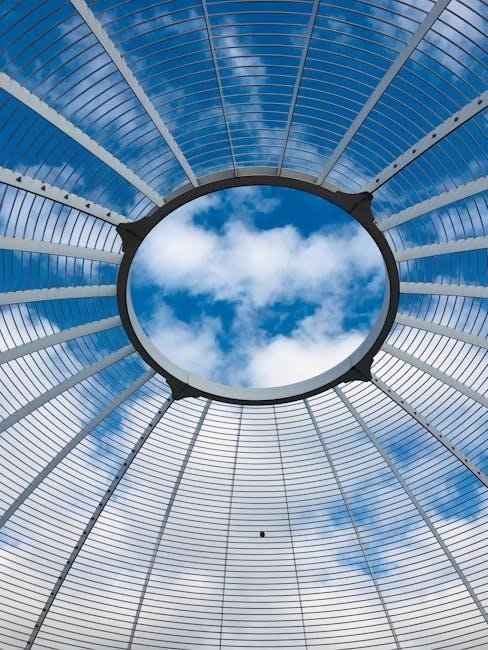
Preparation for Metal Roof Installation
Ensure the roof is clear of debris‚ check for nails or objects‚ and install underlayment. Proper preparation ensures a safe and successful installation process.
Material Checklist
A comprehensive material checklist ensures a smooth installation process. Essential items include metal roofing panels‚ underlayment‚ fasteners‚ sealants‚ ridge caps‚ and flashing. Additionally‚ gather tools like a tape measure‚ snips‚ and a sealant gun. Verify the quantity and quality of materials before starting. Ensure all components comply with local building codes and standards‚ such as AS 1562.1:1992. Proper preparation and having the right materials on hand are critical for a successful metal roof installation.
Roof Preparation Steps
Thorough roof preparation is vital for a successful metal roofing installation. Begin by ensuring the surface is clean and free of debris‚ including nails and old roofing materials. Inspect for structural integrity and repair any damaged areas. For new roofs‚ verify that the substrate is secure and properly aligned. Apply a suitable underlayment to protect against moisture and weathering. Ensure all surfaces are dry and clear of obstructions before proceeding with panel installation. Proper preparation ensures a stable base for your metal roof‚ enhancing durability and performance.
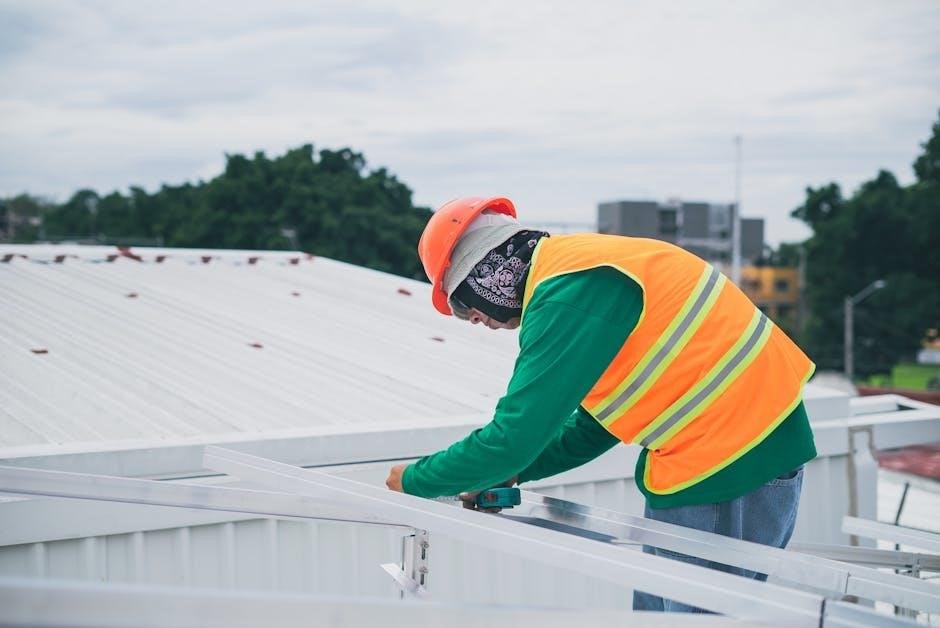
Tools and Materials Required
- Tape measure‚ snips‚ hammer‚ and safety equipment are essential tools.
- Materials include metal panels‚ underlayment‚ fasteners‚ and sealants for secure installation.
Essential Tools for Installation
Installing a metal roof requires specific tools to ensure accuracy and safety. A tape measure is crucial for precise measurements‚ while snips or a saw are needed to cut panels. A hammer is essential for securing fasteners‚ and safety equipment like gloves and a harness is vital for protection. Additionally‚ a sealant gun is necessary for sealing gaps‚ and a drill with screwdriver bits helps in fastening panels. Proper tools ensure a professional finish and prevent installation errors.
Recommended Materials and Accessories
For a successful metal roof installation‚ high-quality materials are essential. Use durable underlayment to protect against weather conditions and ensure a smooth surface. Galvanized or stainless steel fasteners are recommended for their strength and rust resistance. Flashing and sealants are crucial for waterproofing seams and edges. Additionally‚ ridge caps and roof screws with weather-tight gaskets are necessary for securing panels and preventing leaks. Accessories like metal trim and closure strips enhance the roof’s appearance and functionality‚ ensuring a professional finish and long-term performance.
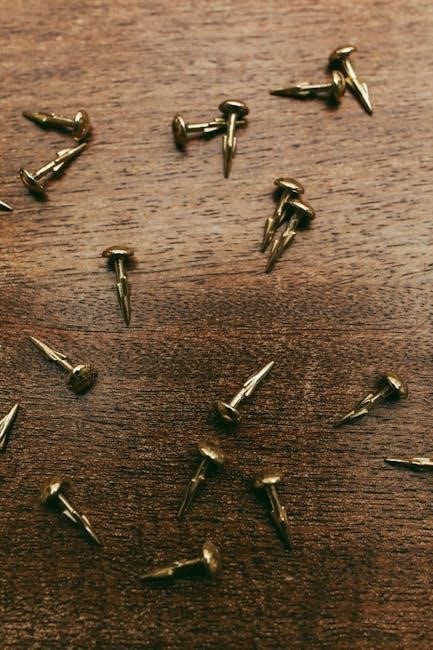
Safety Considerations
Metal roofing installation is hazardous‚ requiring extreme care. Always supervise the process‚ handle panels safely‚ and avoid standing on them until secured. Use proper safety gear and follow guidelines to prevent accidents.
General Safety Guidelines
Ensure proper safety measures during metal roofing installation to prevent accidents. Always wear protective gear‚ including gloves‚ safety glasses‚ and a harness. Use sturdy ladders and maintain a clean work area to avoid tripping hazards. Never stand on unsecured panels‚ as they may bend or collapse. Follow manufacturer instructions for tools and materials. Supervise the process with a trained professional and be aware of weather conditions that could compromise safety. Adhere to local building codes and installation standards to ensure a secure and hazard-free environment.
Handling and Securing Roof Panels
Handle metal roof panels with care to avoid damage and ensure secure installation. Use lifting straps or racks to transport panels to prevent bending or scratching. Secure panels immediately upon placement to prevent wind displacement. Align panels correctly with roof edges and purlins‚ ensuring even spacing. Tighten fasteners gradually to maintain panel flatness and avoid warping. Always follow manufacturer guidelines for handling and securing to ensure structural integrity and safety during installation.
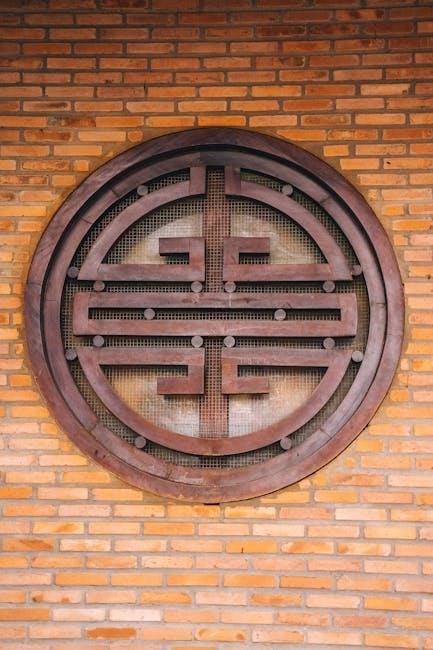
Step-by-Step Installation Process
This section outlines the key steps for installing a metal roof‚ from preparing the surface to final touches‚ ensuring a secure and durable finish always.
Installing Roof Trim and Flashing
Begin by installing roof trim and flashing to ensure a watertight seal. Measure and cut eave‚ ridge‚ and valley trim to fit securely. Use a tape measure and utility knife for precise cuts. Secure trim with compatible fasteners‚ spacing them evenly. Flashing around vents‚ chimneys‚ and skylights prevents leaks; Apply sealant to edges for added protection. Ensure all pieces fit snugly before fastening. This step is critical for maintaining structural integrity and preventing water damage. Always use extreme care and follow manufacturer guidelines for proper installation.
Attaching Roof Panels
Begin by aligning the first roof panel with the eave edge‚ ensuring it is level and square. Secure panels using compatible fasteners‚ spaced evenly as recommended. Tighten snugly to avoid over-tightening‚ which can damage the material. Start at the center and work outward to prevent buckling. Use a level and square to maintain alignment. Apply sealant between panel laps for a watertight seal. Ensure all fasteners are driven into supporting structures like purlins or rafters. Follow manufacturer guidelines for proper spacing and torque. Proper installation ensures a secure‚ weather-tight roof system.
Securing Ridge Caps
Once roof panels are installed‚ secure the ridge cap along the roof peak. Ensure alignment is precise and even. Fasten the cap using compatible screws or rivets‚ spaced evenly for stability. Apply a bead of sealant along the cap’s edges to ensure a watertight seal. Tighten fasteners firmly but avoid over-tightening‚ which could damage the material. Double-check alignment and ensure the cap lies flat. For additional security‚ use clips or brackets if recommended by the manufacturer. Properly secured ridge caps prevent leaks and enhance the roof’s structural integrity. Always follow safety guidelines when working at heights.
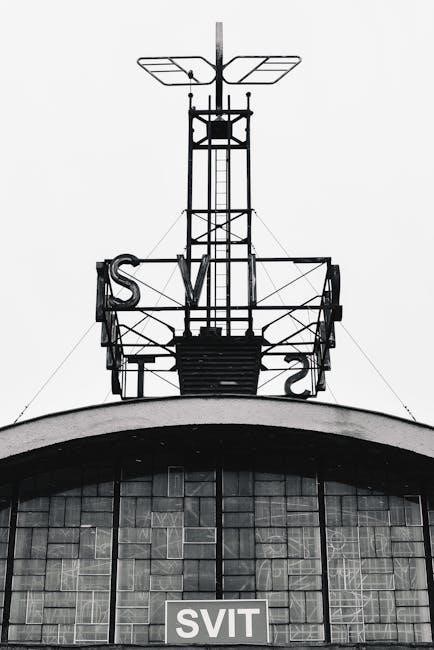
Codes and Standards
AS 1562.1:1992 outlines design and installation requirements for sheet metal roofing‚ ensuring compliance with safety and structural integrity standards. Adherence is crucial for reliable performance and durability.
AS 1562.1:1992 Design and Installation Requirements
AS 1562.1:1992 provides comprehensive guidelines for sheet metal roofing and wall cladding‚ ensuring compliance with safety and structural standards. It covers material specifications‚ design loads‚ and installation best practices. The standard emphasizes proper fastening techniques‚ sealant applications‚ and flashing details to prevent leaks and ensure durability. Compliance with this standard is essential for achieving a structurally sound and weather-tight metal roofing system. Adhering to these requirements helps maintain the integrity and longevity of the roof.
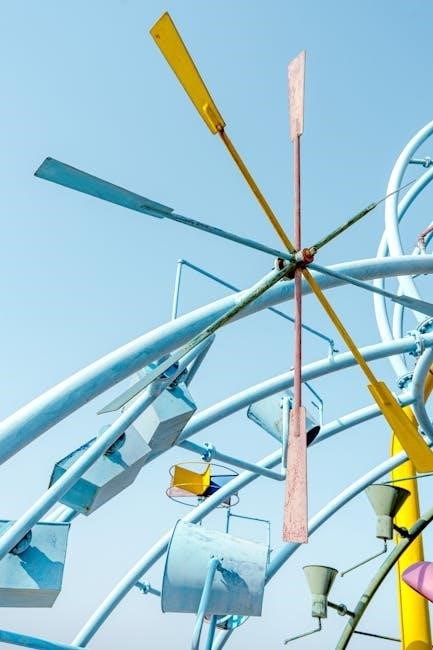
Maintenance and Troubleshooting
Regular inspections ensure longevity. Clean debris‚ check fasteners‚ and address rust spots promptly. Proper upkeep prevents leaks and maintains structural integrity‚ ensuring optimal performance over time.
Regular Maintenance Tips
Regular inspections are crucial for maintaining a metal roof’s longevity. Homeowners should clean debris‚ check fasteners‚ and address rust spots promptly. Clear leaves and branches to prevent damage and ensure proper water flow. Inspect roof edges‚ valleys‚ and flashing for gaps or damage. Tighten loose screws and replace worn-out washers to prevent leaks. Apply a rust-inhibiting coating if necessary. Schedule professional inspections every few years to address hidden issues. Consistent upkeep prevents costly repairs and ensures optimal performance.
Common Issues and Solutions
Common issues with metal roofs include loose fasteners‚ rust‚ and leaks. Regular tightening of screws and replacing worn washers can prevent water infiltration. Rust spots should be sanded and coated promptly to avoid spreading. Ensure proper installation of flashing and trim to prevent gaps. Clear debris regularly to maintain water flow. Address dents or scratches immediately to preserve the roof’s integrity. Standing on panels without support can cause damage‚ so use appropriate ladders or scaffolding. Professional inspections can help identify and fix hidden problems early.
Metal roofing offers exceptional durability‚ energy efficiency‚ and a lifespan of 50+ years‚ reflecting sun rays for energy savings and modern appeal.
Final Inspection and Completion
After installing the metal roof‚ conduct a thorough inspection to ensure all components are secure and properly aligned. Check for loose fasteners‚ damaged panels‚ and gaps in flashing or trim. Verify that all roof panels‚ ridge caps‚ and flashing are tightly sealed to prevent water infiltration. A final walk-through ensures the roof is watertight and meets installation standards. Once completed‚ your metal roof will provide long-lasting protection and energy efficiency for years to come.
Long-Term Benefits of a Metal Roof
A metal roof offers exceptional longevity‚ lasting 50 to 70 years or more‚ outperforming traditional roofing materials. It provides energy efficiency by reflecting solar rays‚ reducing cooling costs. Metal roofs are low maintenance‚ resistant to mold‚ moss‚ and pests‚ and withstand harsh weather conditions. Their durability ensures long-term savings on repairs and replacements. Additionally‚ metal roofing is environmentally friendly‚ as most materials are recyclable‚ making it a sustainable choice for homeowners seeking a reliable‚ modern solution for their homes.